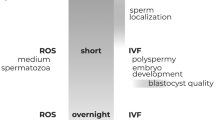Abstract
Purpose: Cytogenetic risk of intracytoplasmic sperm injection (ICSI) after artificial oocyte activation (post-activation ICSI) was evaluated in the mouse.
Methods: Mouse zygotes were produced by ICSI into eggs at various intervals after parthenogenetic exposure to strontium (Sr) for 30 min. Male pronucleus formation and the chromosome constitution were studied.
Results: Sperm nuclei injected into oocytes within 1 h after Sr exposure (from early through mid-telophase) transformed normally into male pronuclei, and the number of chromosome aberrations did not significantly increase in the resultant zygotes. When sperm nuclei were injected into eggs at intervals beyond 1 h after Sr exposure (from late telophase through the G1 pronuclear stage), the rate of male pronucleus formation was significantly reduced. The incidence of chromosome aberrations increased with time between oocyte activation and ICSI.
Conclusions: ICSI into oocytes within 1 h after parthenogenetic activation produces cytogenetically competent embryos in the mouse.
Similar content being viewed by others
References
Chung JT, Keefer CL, Downey BR: Activation of bovine oocytes following intracytoplasmic sperm injection (ICSI). Theriogenology 2000;53:1273– 1284
Hwang S, Lee E, Yoon B, Lee J-H, Choi D: Effects of electric stimulation on bovine oocyte activation and embryo development in intracytoplasmic sperm injection procedure. J Assist Reprod Genet 2000;17:310– 314
Tesarik J, Sousa M: More than 90% fertilization rates after intracytoplasmic sperm injection and artificial oocyte activation with calcium ionophore. Fertil Steril 1995;63:343– 349
Zhang J, Wang C-W, Blaszcyzk A, Grifo JA, Ozil J, Haberman E, Adler A, Krey L: Electrical activation and in vitro development of human oocytes that fail to fertilize after intracytoplasmic sperm injection. Fertil Steril 1999;72:509– 512
Nakagawa K, Yamano S, Moride N, Yamashita M, Yoshizawa M, Aono T: Effect of activation with Ca ionophore A23187 and puromycin on the development of human oocytes that failed to fertilize after intracytoplasmic sperm injection. Fertil Steril 2001;76:148– 152
Nakagawa K, Yamano S, Nakasaka H, Hinokio K, Yoshizawa M, Aono T: A combination of calcium ionophore and puromycin effectively produces human parthenogenones with one haploid pronucleus. Zygote 2001;9:83– 88
Tesarik J, Rienzi L, Ubaldi F, Mendoza C, Greco E: Use of a modified intracytoplasmic sperm injection technique to overcome sperm-borne and oocyte-borne activation failures. Fertil Steril 2002;78:619– 624
Yanagida K, Katayose H, Yazawa H, Kimura Y, Sato A, Yanagimachi R, Yanagimachi H: Successful fertilization and pregnancy following ICSI and electrical oocyte activation. Hum Reprod 1999;14:1307– 1311
Komar A: Fertilization of parthenogenetically activated mouse eggs. Exp Cell Res 1982;139:361– 367
Hoshi K, Yanagida K, Sato A: Pretreatment of hamster oocytes with Ca2+ ionophore to facilitate fertilization by ooplasmic micro-injection. Hum Reprod 1992;7: 871– 875
Maleszewski M, Borsuk E, Koziak K, Maluchnik D, Tarkowski AK: Delayed sperm incorporation into parthenogenetic mouse eggs: Sperm nucleus transformation and development of resulting embryos. Mol Reprod Dev 1999;54:303– 310
Chatot CL, Ziomek A, Bavister BD, Lewis JL, Torres I: An improved culture medium supports development of random-bred 1-cell mouse embryos in vitro. J Reprod Fertil 1989;86:679– 688
Toyoda Y, Yokoyama M, Hoshi T: Studies on the fertilization of mouse eggs in vitro: I. In vitro fertilization of mouse eggs by fresh epididymal semen. Jpn J Anim Reprod 1971;16:147– 151
Kimura Y, Yanagimachi R: Intracytoplasmic sperm injection in the mouse. Biol Reprod 1995;52:709– 720
Mikamo K, Kamiguchi Y: A new assessment system for chromosomal mutagenicity using oocytes and early zygotes of the Chinese hamster. In Radiation-Induced Chromosome Damage in Man. T Ishihara, MS Sasaki (eds), New York, Alan R. Liss, 1983, pp 411– 432
Tateno H, Kimura Y, Yanagimachi R: Sonication per se is not as deleterious to sperm chromosomes as previously inferred. Biol Reprod 2000;63:341– 346
Tateno H, Kamiguchi Y: Improvement of male pronuclear formation during cross-fertilization between Chinese hamster spermatozoa and Syrian hamster oocytes by nocodazole, and chromosome analysis of hybrid zygotes. Mol Reprod Dev 1999;52:117– 124
Tateno H, Kamiguchi Y: Dithiothreitol induces sperm nuclear decondensation and protects against chromosome damage during male pronuclear formation in hybrid zygotes between Chinese hamster spermatozoa and Syrian hamster oocytes. Zygote 1999;7:321– 327
Author information
Authors and Affiliations
Corresponding author
Rights and permissions
About this article
Cite this article
Tateno, H., Kamiguchi, Y. How Long Do Parthenogenetically Activated Mouse Oocytes Maintain the Ability to Accept Sperm Nuclei as a Genetic Partner?. J Assist Reprod Genet 22, 89–93 (2005). https://doi.org/10.1007/s10815-005-1498-0
Received:
Accepted:
Issue Date:
DOI: https://doi.org/10.1007/s10815-005-1498-0




